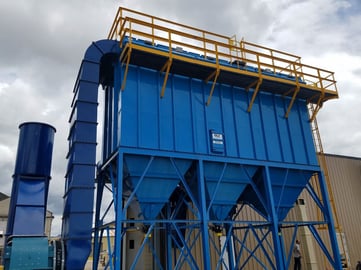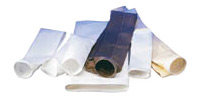Dust Removal: The Essential Function of a Baghouse
When an industrial process generates dust, that dust may become entrained in the air. A baghouse is the go-to solution for controlling airborne dust, also called particulates, for a healthier, more productive manufacturing environment with less downtime. Dust is captured either for disposal if it is waste or to reclaim valuable fugitive dusts, such as lithium carbonate dust, a mineral used in the production of lithium ion batteries. Keeping as much of this dust in the manufacturing process is critical to the manufacturer’s bottom line.
Baghouse size varies according to process need. A baghouse can be as small as a refrigerator to filter 500 CFM of air (the volume of the air stream measured in cubic feet per minute). Sly’s typical application volumetric flows range from 250 CFM to 100,000 CFM. The image below is an example of a larger Sly, Inc. baghouse installation.

The operating principal of a baghouse is induced or forced air filtration. Air is filtered when it passes through a bag, the filter medium. Dust particles are too large to pass through the filter, much like coffee grounds are too large to pass through a coffee filter, unless the coffee filter is torn. In a baghouse, dust is caught on the filter bag’s exterior, or upstream side, and left behind as the air continues downstream.
A baghouse removes particulates with a collection efficiency of 99.9+%. Often, the air continues up a stack and exits to the atmosphere, and any remaining particulates are exhausted as emissions. Sometimes, a process requires recirculating the exhaust air back indoors, for example, to reduce heat loss in cold climates.
Dust Clings to Dust
Like an industrial-sized vacuum cleaner, a baghouse is designed to capture dust and remove it from the air stream. But not all dust must be removed from the baghouse. Within limits, a cake of dust on the filter media is desirable because it helps to enhance filtration. Just as a pump needs to be primed to create enough operational pressure, a baghouse often needs dust to create sufficient filtration. Dust is the reason for filtration, and also an essential part of filtration. Let's see why.
 On first glance, it might appear that a brand-new filter bag (see right) might do the best job of filtration, but the nature of dust turns this obvious, but incorrect, assumption on its head. The best filtration is accomplished when the bags have been seasoned by the accumulation of just the right amount of dust on the surface.
On first glance, it might appear that a brand-new filter bag (see right) might do the best job of filtration, but the nature of dust turns this obvious, but incorrect, assumption on its head. The best filtration is accomplished when the bags have been seasoned by the accumulation of just the right amount of dust on the surface.
A Look at Air Flow
Incoming dust-laden air is drawn through the baghouse by fan power. Dirty air is either pushed into the baghouse by a forced draft fan at the inlet (positive pressure) or pulled from the baghouse by an induced draft fan at the outlet (negative pressure).
Inside the baghouse, a series of bags supported by metal cages hang from the top on a tubesheet. The filter bags, which resemble 8-to-12-foot-long tube socks, are fitted over the cages. Filter bag materials are matched to specific application conditions.
Unfiltered air enters the baghouse in the open cavity that surrounds the many bags. Next, it passes through the bags that serve as filter media, leaving behind a layer of particulates on the exterior, or surface, of the bags. The clean air then continues downstream, either to the stack or into process recirculation.
Pulse Jet Cleaning
The cleaning cycle can be activated on a timed sequence or by reaching a preset differential pressure that indicates dust must be removed from the collector. This pulse-on-demand mode triggers the pulse jet system to clear excess dust from the bags when the high point is met and turned off when the low point is reached.
Many pulse jet cleaning systems employ a right-angle body diaphragm valve. Air comes in from one direction and flows out at a 90-degree angle. An internal diaphragm controls how much air passes through the valve. The diaphragm valve has an upper and a lower chamber with a flexible diaphragm separating them. The lower chamber connects to the pulse pipe; the upper chamber connects to a solenoid valve. The solenoid core seals off an exhaust port. When current from the timer passes through the solenoid’s coil, it creates a magnetic field inside it that pulls up the inner metal core and opens the solenoid valve, so the air from the upper chamber of the diaphragm valve can escape into the atmosphere. The resulting pressure imbalance inside the diaphragm valve flexes the diaphragm, allowing the air from the compressed air manifold to pass through the pulse pipe into the dust collector to start cleaning.
Surface dust is dislodged by the pulses of compressed air and drops into the hoppers below. To minimize the amount of dust that gets re-entrained, the rows of bags are not pulsed in sequence. Throughout the procedure, the baghouse remains online. Filtration continues during pulse jet cleaning. For more information on this topic, see Dust Collector Filter Cleaning: Compressed Air Requirements for Cleaning Bag Filters.
Dust Removal: Hoppers
Once the captured dust falls into the hoppers, it is continuously removed to prevent buildup, which could lead to dust bridging or solidification. Typically, a rotary valve or screw conveyor clears the dust from the hopper. An air seal prevents the dust in the hopper from returning to the air stream.
For More Information
To help you familiarize yourself with modern baghouse solutions, we’ve created the Baghouse 101 video training series. Access the videos or contact us if you have questions.
Tags: baghouse




